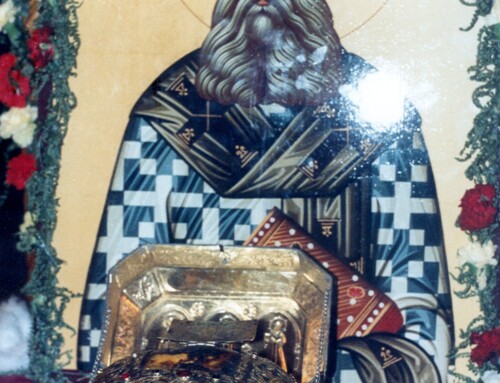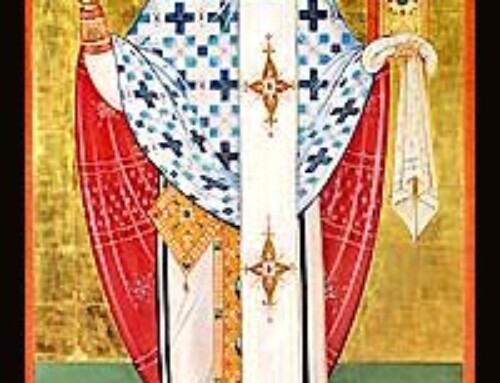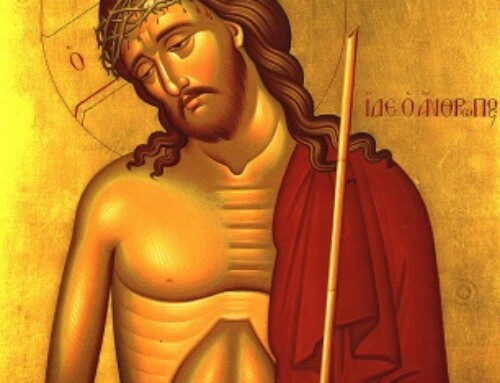(Originally published in THE WORD – February 1993)
HOPE
by Archpriest Joseph Allen
In the Christian community there is no service, no “ministry,” rendered — either from clergy to laity, or laity to each other — unless the basis of that service is hope. If that is true — and it is — every Christian must seek to better understand the meaning of hope as one lives and serves in that community. We begin with the hope transmitted through the clergy, but will not end there.
It is writer, Heije Faber, who in his book Pastoral Care in the Modern Hospital, can give us our lead into this quality of hope; this he does as he presents to us a quite unexpected analogy. This author compares, deliberately and not cynically, the clown with an “agent of hope” He uses this analogy as a way of thinking about the contemporary priest/pastor as a person who embodies this hope. His point is that the clown is a necessity in the circus since he brings a continuity to it, carrying with him the genuine human thread that runs throughout the entire circus. Indeed, he “holds it together” so that the circus is a coherent and meaningful process, rather than a mere series of unrelated acts and entertaining exercises. Anyone who has ever been to the circus knows that this is true.
Staying with this analogy for a moment — and for purposes of our own subject — is it not true that the one who ministers today is just like the clown is to the circus: the genuine human threat which “holds together” the entire gamut of positive and negative experiences in the communal life? For example, does he not have to weave together in a meaningful manner, the experience of sorrow as expressed in the funeral service, “I weep and I wail when I think upon death …,” and yet also the joy expressed in the marriage sacrament, “Crown them with glory and honor?” In short, does this one not offer coherence to a life that extends from birth, to baptism, to marriage, to death? Indeed, this quality of “holding together” as a function of one’s leadership within the community has been labeled by the Church Fathers as a major one; they use the word syneches to describe this capacity.
We use this analogy of the clown with the one who ministers not as an ending point unto itself. Rather this analogy is used to raise this question: “With what does he go about ‘holding together’ this broadest spectrum of human experiences within the communal life?”
Listen to Faber’s point regarding the clown, now as he reflects this task of ministry:
. . . to show the ability to find the genuine, the authentic, on the edges of life; the wry smile in the face of failure; the strange victory of the man who recognizes his weakness, his powerlessness and failure, and yet who accepts it as a part of the scheme of things; the ‘little man’ who continues to have faith in something indestructible. (Heije Faber, Pastoral Care in the Modern Hospital, 1971) p. 82.
But what is it that allows him to “find the genuine, the authentic, on the edges of life?” Whence the “wry smile in the face of failure?” And how does he continue “to have faith in something indestructible?” Our theme, hope, holds the answer.
For both the ministry of the clergy and laity, the truth is that as we live in the various boundary situations of our communal existence — anxiety, fear, grief, the absurd, setbacks of all sorts it is just one such image of the clown which speaks to our theme. This can be said now in terms of hope, because
… of the clown, it can be said that he has an openness and sympathy in love; a feel for the fringes of human life; a kind of inner freedom; the ability to share suffering, compassion, humor … a great deal of patience and wisdom. (Ibid., p. 84)
None of these most valuable qualities — openness, sympathy, inner freedom, humor, etc. — each a crucial dimension in this “holding together,” is possible in a Christian community if it is not build upon hope. This is what the scripture knows as elpis, hope, “the anchor of the soul.”
What, then, can be said about this great Christian virtue?
It was St. Paul who nobly wrote about the three theological virtues: faith, hope and love. And he did say that of the three, the greatest is love. We would, of course, have to add that where any one of these virtues exist, all three exist at that same moment. But it is also true that today so much is written about, and taught about “faith and love,” that seldom do we hear about hope. And yet in both the Old and New Testament we are told, time and again, that our very salvation depends upon hope.
Why, then, do we not see more about this virtue? Is it because faith and love are easier to understand? Is it because we easily confuse “hope” and “wishful thinking?” Is it because we are caught up in our cultural trappings; that is, in which life seems so full of futility and despair, indeed a life that seems bent upon cynicism and helplessness to change things? These — and others like them — are qualities that “hang heavy” in the air, and they lead us into a “hopeless theology.”
The fact that we read and hear so little about hope; is this all bad?
Yes and no. Yes, because we are never to be without hope. No, because it seems to remind us of that precise message; from whence comes our hope? “Our help is in the name of the Lord who made heaven and earth!” (Psalm 124.8). It comes from nothing and nobody in this world; it comes from the Lord, and for Christians it comes from Christ. “Glory to Thee, O Christ our God and our hope, Glory to Thee!” (The Dismissal of the Liturgy). For the Christian, hope is located precisely in the Resurrection, for when Christ rises, all powers of death and darkness are overcome, and hope is given to us from beyond this world. “Fear not, I have overcome the world” (Luke 12:32).
The great martyr, St. Ignatius of Antioch, was willing to die for God, because he knew that his hope emanated not from this world (which itself is passing away and dying), nor from the judgments and opinions of other persons, but from the eternal life established by Christ in the Resurrection. This is the “radical” nature of the Christian claim: we have the true hope because of what is accomplished in the Resurrection. Otherwise dying is simply dying. That is absolutely hopeless. But if in dying we die in this hope, that is, with our eye turned toward He who freely entered death to “convert” it into life, then what was darkness becomes the way to light, what was despair becomes the way to joy. This affects not only how we are to die, but precisely how we are to live, for it is so true that one never knows how to live until he learns how to die.
Yes indeed, in this world we do have tribulation. Yes indeed, in this world we do have futility and death. Yes indeed, starvation and “rumors of wars” Yes indeed, our enemies attack us on the left and on the right. But our proclamation is that of the Psalmist: “For God alone my soul waits in silence, for my hope is in Him” (Ps. 62:5). Hope, then, is not a matter of the worldly intellect or worldly judgments; it is a word spoken by God to which the human heart must respond.
But what must the heart discern in order to hear this word of hope, this word spoken by God? There are various issues which must be understood before we can answer that question.
The first issue is raised by Paul Prusyer, who in his “Phenomenology and Dynamics of Hoping” (in The Journal of Scientific Study of Religion, 1963) reminds us of a type of worldly, intellectual vagueness regarding hope. His point is that sometimes hope is thought of like health; it is only “intellectually” described in relationship to illness. Hope, then, for those in the secular world of helping, has been seen only, in contrast to illness and helplessness.
But for the Christian, there is no vagueness, and no contrast is needed: “My hope is in the Lord.” That is why we see that hope is often useful in conjunction with faith, e.g., in 1 Corinthians 13 and Hebrews 11. Indeed, there are in my concordance, equivalencies for this usage of the word “hope” which add up to some 120! It is also why it is attached to love. For example, Schubert Ogden writes, “The love of God is itself the object of Christian hope, as well as its ground,” (“The Meaning of Christian Hope,” 1975). This faith and love which describes hope, then, implies a relationship and community, each of which must be “entered into” (and this is critical) rather than “a concept to be believed.” Such hope requires a willing surrender to a power, an unconquerable but eternal force, outside us, something which is not ourselves. And that is God. This tells us that hope is not an idea; it is a relational mode into which one enters.
Because this is true, we are forced to deal with a communion that gives birth to “hopeful beings” Such beings abide in hope:
St. Paul’s statement is that hope should abide, but Kant’s questions ‘What can I hope?’, Kierkegaard’s studies of ‘unhope or despair, the secular existentialists’ descriptions of pathological hopelessness, emptiness. . . are unthinkable within the Christian tradition. (Prusyer, p. 87).
Thus, the question is not only whether one has or does not have hope as a “mood,” as a subjective wish which satisfies my immediate desires. Rather, it is to be a primal mode of existence for a person of faith; it is a “faith and love” state of the Christian.
This means that we must understand the difference between “wish” and “hope.” We wish that, but we hope in. Hope is not directed toward immediate and concrete guarantees, toward conditions, toward comfort, toward “insurances.” Here is where the logic of this world will drive us: to a type of “commodity” orientation. The best example of a true hopeful attitude, however, is the child toward his mother. The child is constantly asking for the very concrete things, but his ultimate love for his mother does not depend upon the fulfillment of these wishes. He knows that she only wants what is good for him, although he may cry or be very angry. He soon learns that wish focuses on the gift, while hope focuses on the giver of the gifts. This is telling us that wishing is usually transient and self —centered, while hope is always hoping with and in God.
Secondly, we must remember that hope stands between what is actual and what is possible, between “what is” and the “not yet.” Indeed, it is not seen now; “Now hope that is seen is not hope. For who hopes for what he sees?” (Romans 8:24). If it rests for the Christian to have hope as a response to the God who loves us (upon which he can put no conditions!), he must have this same relationship with another person in the communion of love. This is true because hope, which is born of such love, bears expectations which lovers never set as demands. With hope we make no demands, and may even suffer at the hands of others. But it matters not, because this hope expresses the very nature of the love of God and His communion. This means that even if one’s wish is not granted, hope, because of such a relationship with God and His community, can abide.
Thus, hope is given, received, found. One hopes with, through, and even for, someone else. It is a shared experience and is generated in the relationship of love which transcends oneself. The solitary person can indeed wish, i.e., apart from this hoping communion. But true hope comes within the hoping community which never ends with an immediate or concrete situation. It is rather a vision and perspective which can grant freedom to a person, regardless of either the positive or negative context in which one lives.
Now we know that some of our readers will have to re-read carefully these last few paragraphs. But that is okay. Perhaps that is why not much is really written about hope — true Christian hope; it is not an easy subject. Maybe it’s best merely to remember the clown and then, with true love and faith, hope will also abide.
Father Joseph is Assistant to Metropolitan PHILIP and Pastor Emeritus of St. Anthony Church, Bergenfield, NJ. This was originally written as the third part of a trilogy, following Grief and Grace.
THE WORD/FEBRUARY 1993; pp. 7-8





